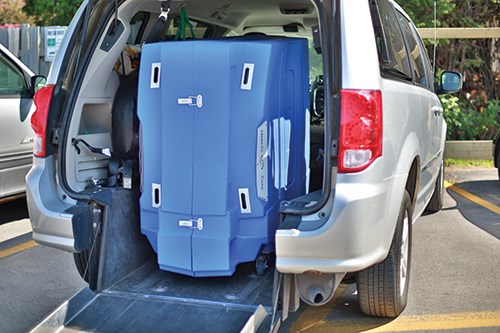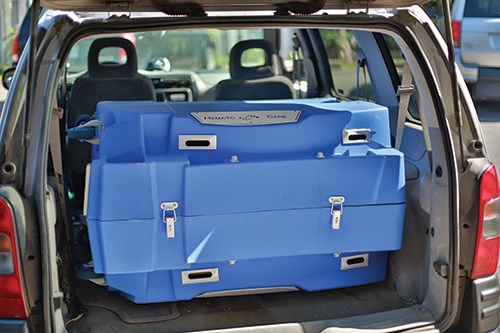Hyperbaric chamber: Portable, pliable FRP handles pressure
Groupe Médical Gaumond Inc. (GMG, Terrebonne, Quebec, Canada) premieres HematoCare, its portable, collapsible composite hyperbaric chamber.
Hyperbaric Oxygen Therapy (HBOT) is recognized by Health Canada (Ottawa, Ontario), the U.S. Food and Drug Admin. (FDA, Washington D.C.) and European health agencies as an effective treatment for more than a dozen medical conditions, including carbon monoxide poisoning and decompression sickness. Patients are placed inside a hyperbaric chamber pressurized to greater than 1 bar/14.5 psi, where they breathe 100 percent oxygen through a mask or hood. These rigid, multiplace chambers (they accommodate multiple patients) weigh around 1,500 kg/3,307 lb. Although there is a market for portable, single-place chambers, the “soft” (collapsible) vessels they would require, until recently, could not sustain pressures high enough for HBOT. Groupe Médical Gaumond Inc. (GMG, Terrebonne, Quebec, Canada) has changed that.
GMG’s HematoCare hyperbaric chamber comprises three composite parts: a control station, a transport case that doubles as the chamber base, and a unique flexible pressure vessel. The vessel is filament wound with Kevlar aramid fiber (DuPont Protection Solutions, Richmond, Va.) impregnated by a specially developed resin that provides flame resistance and strength sufficient to meet pressure loads. It’s rated at 3 ATA (absolute atmosphere) or 29.4 psig/2.0 bar, but has a Shore A hardness of only 25 — softer than a gel-type shoe insole. As a result, the vessel can be folded in on itself (see photo immediately below), yet has withstood 9.31 bar/135 psi during burst testing. Assembled, HematoCare is 2.5m/8.2 ft long with a maximum diameter of 1.1m/3.6 ft, but it collapses to 0.7m/2.3 ft long — compact enough for transport via crossover utility vehicle (see bottom photos). Not surprisingly, GMG has patented multiple aspects of the HematoCare, including the innovative fire retardant used in the vessel membrane.
Determining the optimum winding angles and pattern was the key to its pliability and dimensional stability. In fact, the composite’s high strength-to-weight ratio helped GMG match the performance of steel and acrylic hard chambers, yet at 125 kg/276 lb, it’s roughly one-eighth the weight of the lightest HBOT-approved rigid vessels.
A 2014 JEC Innovation Award winner in the medical category, HematoCare is targeted not only to medical care facilities, but diving centers and professional sports team facilities as well.
Related Content
-
Post Cure: Natural mineral fiber biocomposite via AFP enhances implant integration
Arctic Biomaterials produces high-quality composite biomaterials incorporating a natural mineral fiber that is useful in medical and healthcare-related fields.
-
Cevotec’s fiber patch placement is part of digital process chain for automated composite prosthetics
Multiple partners work to develop automated data collection, composite laminate generation for customized medical applications using FPP technology in German-funded Patch2Patient project.
-
Filament winding increases access to high-performance composite prostheses
Steptics industrializes production of CFRP prostheses, enabling hundreds of parts/day and 50% lower cost.















.jpg;maxWidth=300;quality=90)

